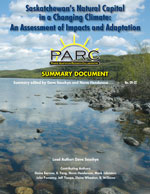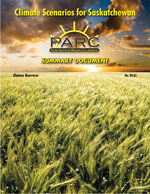Saskatchewan
PARC's Latest Research on Impacts and Adaptation in Saskatchewan
Climate Scenarios for Saskatchewan
The construction of Climate Scenarios for Saskatchewan was undertaken by PARC in 2008-09. This resulted in the creation of scenarios of climate change for Saskatchewan using the most recent global climate model (GCM) results available.
In this report (Barrow, 2009), future climates for Saskatchewan are illustrated by mean annual temperature, annual precipitation total and annual moisture index for the 2020s, 2050s and 2080s. The report addresses the question of what projected changes in global climate mean for Saskatchewan, specifically.
Key Findings:
- Increase in Temperature and Precipitation: Temperatures are expected to rise. Precipitation is also projected to increase.
- Seasonal Variation in Temperature and Precipitation by the 2050s: Winter will experience the greatest temperature changes, while precipitation change is most pronounced in the winter and spring for the forest areas and spring for the grasslands.
- Drier Climate with Increased Variability: Overall, on an annual basis, our climate will be drier, owing largely to increased evapotranspiration from warmer temperatures. A shift to warmer winters and drier summers is likely. Most of the risk from climate change will be an increase in the year-to-year variability, and from climate scenarios that project drought and unusually wet years with greater severity and frequency than in the past.
This report then allowed PARC to perform a biophysical assessment of climate change impacts and adaptation options in Saskatchewan, which is described below.
Climate Change Impacts on Saskatchewan's Natural Capital:
This provides a summary of key findings and a brief overview of options for managing the impacts of climate change in Saskatchewan through adjustments in policy, management practices and decision-making processes.
In 2009, PARC prepared a report specifically on impacts and adaptations on Saskatchewan's landscape for the Saskatchewan Ministry of Environment.

This report provides an overview of the scientific understanding of the impacts of climate change on Saskatchewan's water resources, soil landscapes and ecosystems, and the key sectors of the provincial economy, agriculture and forestry, that depend directly on this natural capital. The other major component of this biophysical assessment of climate change is the identification and discussion of adaptation options and strategies that could limit exposure to future climate risks and help adapt to new conditions.
The following are the key findings and conclusions arising from this report. Read these, and consider if these climate impacts affect you directly or indirectly in some way. They likely do.
Key Findings
- Biophysical Impacts: The major biophysical impacts of climate change in Saskatchewan are seasonal, annual and geographic shifts in the distribution of water resources and plant and animal species.
- Water: One of the most certain projections is that extra water will be available in winter and spring while summers will generally be drier as the result of earlier spring runoff, with a longer, warmer summer season of water loss by evapotranspiration.
- Temperature: Much of the observed and projected warming in Saskatchewan is during winter and spring, such that the frost-free growing season is getting longer and expected to lengthen as the climate warms.
- Plant Productivity: A longer warmer growing season will favour diversification of prairie agriculture and higher crop, pasture and forest productivity. However, potentially higher productivity will be limited by available soil moisture.
- Community Impact: The impacts of climate change tends to be adverse because our communities and resource economies are sensitive to fluctuations in the quantity and quality of natural capital and they are not adapted to the projected larger range of climate conditions.
- Net Impacts: The net impacts of climate change depend heavily on rates of climate change and how effectively we adapt. South of the Churchill River, nearly all of Saskatchewan's ecosystems and water resources are actively managed. We will need to adjust our management in tune with the changing climate.
- Drought: The recurring impacts of drought in Saskatchewan suggest that the severity and duration of future droughts will determine much of the impact of climate change. Droughts, and to a lesser extent flooding, could limit opportunities provided by a warmer climate and will challenge our capacity to adapt to changing conditions.
- Mainstreaming: We need to incorporate climate change into existing planning and policy practices.
Options for Managing Climate Change
Adjustments in policy, management practices and decision-making processes
- Water: The people of Saskatchewan have historically managed their water resources while maintaining a healthy aquatic environment because there has been a relatively abundant supply of high quality water to meet the needs of communities and the economy. However, fluctuating water supplies in recent years have stressed the need to make some adjustments in our approach to managing this renewable, but finite, resource. Uncertain water supplies could require major innovations in planning and managing how water is allocated, stored, used and distributed. Integrated basin management of the South Saskatchewan River across both Alberta and Saskatchewan and for smaller watersheds in Saskatchewan is the preferred adaptation method for dealing with these uncertainties. Integrated basin management plans with apportionment powers, enforceable land use controls and agricultural management incentives may need to be implemented to deal with rapid changes and increased uncertainties in water flows and availability.
- Adaptation and Decision Making: Examples of policy and decision-making processes that are suitable for the planning of adaptation to climate change include environmental farm plans, watershed basin councils, and principles of adaptive forest management and integrated water resource management. Policies must be evaluated in terms of how they support adaptation. Similarly, management practices and processes must be considered from the perspective of adaptation in order to embed decision making about climate change into the planning and management process.
- Variation in Capacity to Adapt: Adaptation on the farm, in the forest, and in local communities is largely achieved by municipalities and individuals working collectively in social networks and in informal institutions (e.g. producer co-ops). The provincial government plays a critical role in terms of facilitation and a policy framework that enables proactive and effective adaptation. In Saskatchewan, adaptive capacity varies among communities, but it is generally high given our financial resources, natural capital, stable governance institutions and strong social capital. Adaptive capacity is low in some rural and northern communities in Saskatchewan, and in some First Nations. However, capacity is only the potential to respond. It must be mobilized by government, businesses, communities, individuals, and other actors.
Next Page › The Prairie Provinces
Sources:
- Barrow, E. (2009a): Climate Scenarios for Saskatchewan. PARC, 131 p.
- Barrow, E. (2009b): Climate Scenarios for Saskatchewan. PARC Summary Document No. 09-01, 15 p.
- Henderson, N. and Sauchyn, D. editors (2008): Climate Change Impacts on Canada's Prairie Provinces: A Summary of our State of Knowledge. PARC Summary Document No. 08-01, 19 p.
- Sauchyn, D. et al (2009): Saskatchewan's Natural Capital in a Changing Climate: An Assessment of Impacts and Adaptation. PARC, 162 p.
- Sauchyn, D. and N. Henderson, editors (2009): Saskatchewan's Natural Capital in a Changing Climate: An Assessment of Impacts and Adaptation. Summary Document. PARC Summary Document No. 09-02, 19 p.
- Sauchyn, D. and Kulshreshta, S. (2008): Prairies; in From Impacts to Adaptation: Canada in a Changing Climate 2007, edited by D.S. Lemmen, F.J., Warren, J. Lacroix and E. Bush; Government of Canada, Ottawa, ON p. 275-328.
